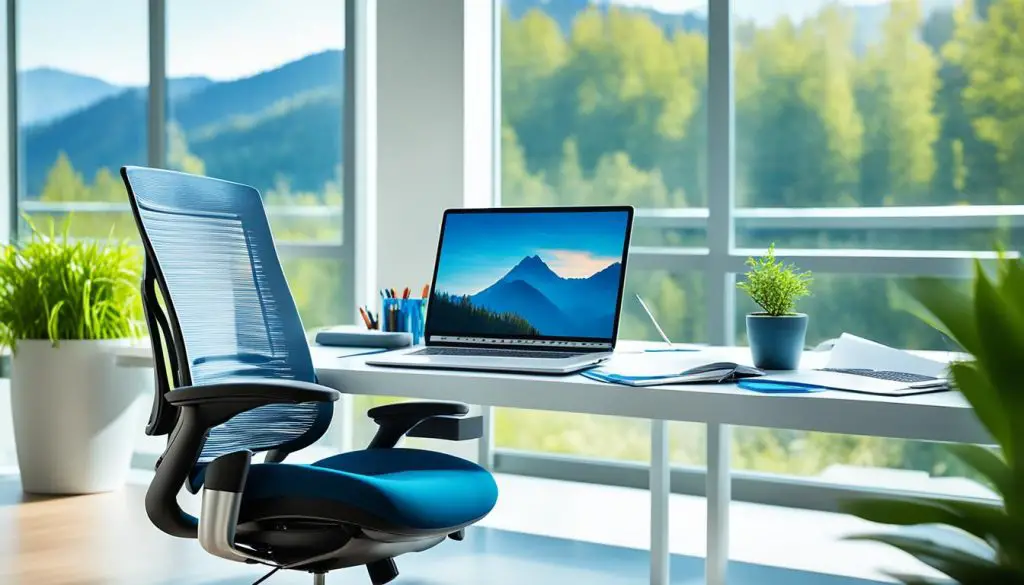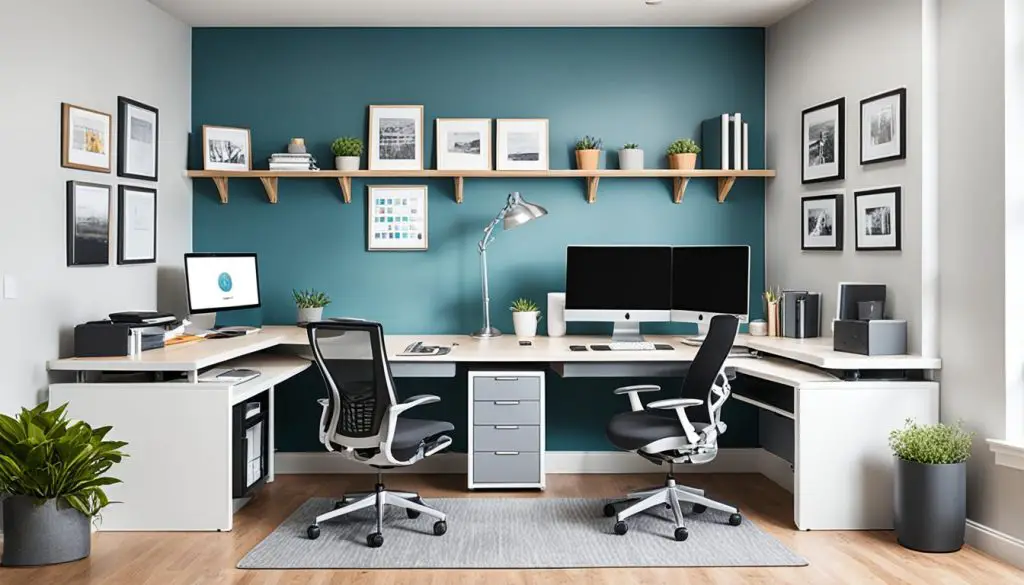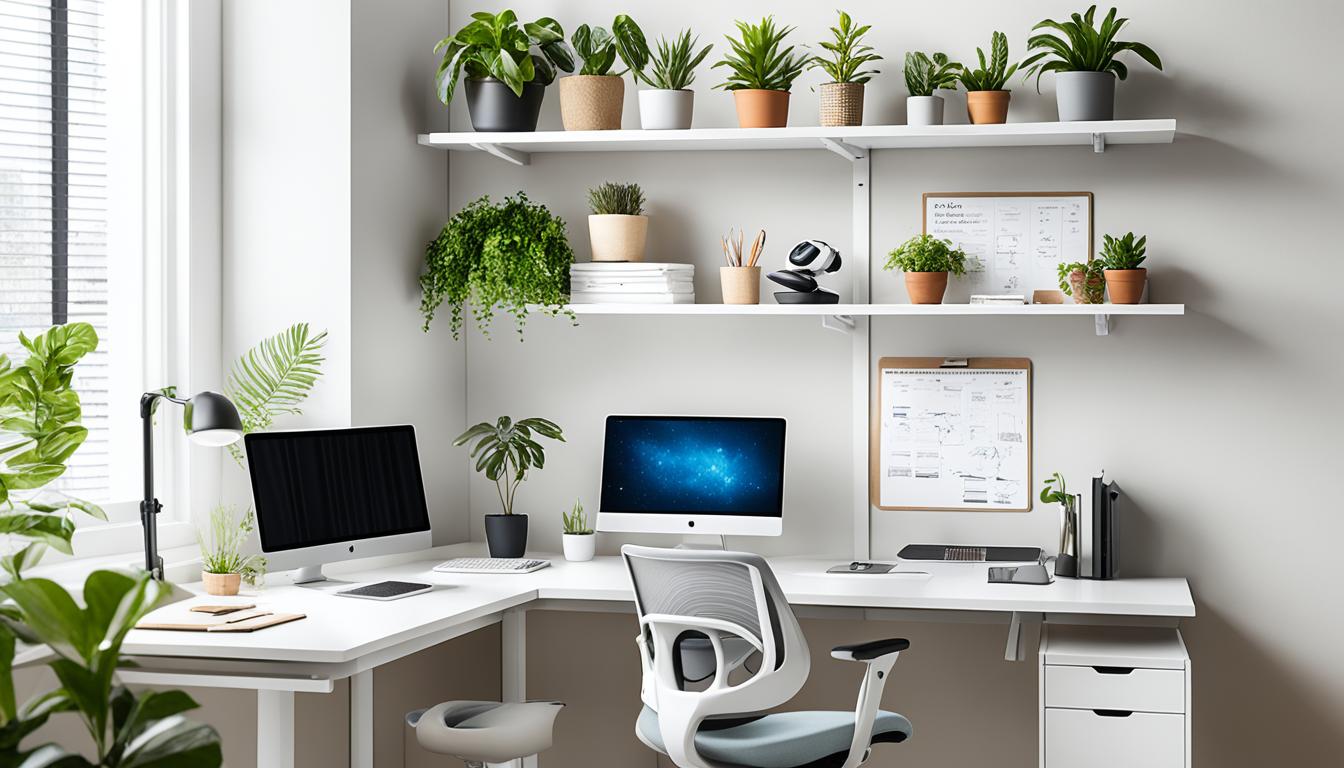My wife’s struggle with endometriosis and fibromyalgia has shown me the importance of a supportive home. A well-designed workspace can boost your productivity and happiness. For those dealing with chronic illnesses, a thoughtfully designed home office is essential.
Did you know, nearly 56% of US workers, or about 9 million Americans, work from home part-time?1 For people like my wife, a home office can be a place of comfort. By focusing on Chronic Illness-Friendly Home Office Design, you can make a space that improves your work and life. Picture a room that fights tiredness, sharpens your mind, and supports your creativity, all while meeting your special needs. Isn’t that what everyone deserves in their work space?
The Power of Environment on Well-Being
Have you felt more alive in a clean, light-filled area lately? It’s normal. A tidy and bright space can boost energy and make you feel happier. On the other hand, living in a cluttered, dark place could bring you down and cause stress. This connection between you and your environment is called Environmental Psychology. Designers and architects use this knowledge to craft spaces that enhance your life.
Environmental Psychology: Designing for Health and Inspiration
People in the West are indoors most of the time. This is especially true for work days. So, having a beautiful, health-boosting workspace is vital. It can increase how much you enjoy your work, your happiness, and how well you do in your job.
Creating an Inspiring and Productive Work Space
Today, more than half of us live in cities. This means we’re not around green spaces as much. As a consequence, our indoor spaces have become really important for our health and happiness. Homes and offices use a lot of energy. That’s why it’s crucial to design them in a way that’s good for us and the planet. This involves focusing on things like how the space is lit, the air quality, and reducing noise.
Research shows that people are happier and more satisfied with their workspace in green buildings. A well-designed home office can do wonders for how you feel about your work. It can make you more productive and bring you more joy and success.
The Sit-to-Stand Workstation
Combating the Sitting Epidemic
A top-notch sit-to-stand desk, like the one from Maverick Desk, can change how you work. It fights the bad effects of sitting too much. This “sitting” problem is a big health risk. It can lead to diseases like heart problems and diabetes.2
We tell our customers to get a good sit-to-stand desk and a comfy floor mat. Standing for 15-20 minutes every so often is great for your health. It boosts your metabolism, gets your blood flowing, and helps your muscles. Sitting too long is bad news. It can increase your chances of getting heart issues, diabetes, and high blood pressure.3
Quality Sit-to-Stand Desk Options
Companies like HumanScale, Maverick Desk, and Herman Miller make great sit-to-stand desks. You can also find good ones at places like Room and Board. And the anti-fatigue mat is a must. We recommend Smart Step mats. They’re green, have different thicknesses, and a 10-year guarantee.2
Lighting for Optimum Cognitive Function
A well-functioning office should have three light sources. These are overhead ambient light, task light, and natural light. These lights help improve your thinking, keep your eyes feeling good, and make you happier.4 If you’re doing lots of Zoom calls with clients, set up your desk by a window. Not only does it light your face for a better look, it also reduces screen glare and brings you closer to nature.
Three Light Sources for Ideal Office Lighting
The kind of light you pick affects how your room’s colors look. Bulbs over 3000 kelvin can make everything look dull. So, double-check the bulb’s label when you buy them.4 We recommend 2700 kelvin bulbs because they give off a cozy light.
Choosing the Right Color Temperature
A fresh paint color can make a big difference in your space, without a big cost. It also lifts your mood. If painting all walls seems like too much, choose one wall to be the focus. Pick a bold color that goes well with the other walls.
Painting with Color for Mood Elevation
Chronic Illness-Friendly Home Office Design
To make a Chronic Illness-Friendly Home Office Design, focus on your health and happiness. This means creating a work area that meets your specific needs. It improves how well you work, reduces tiredness, and makes you feel motivated and happy. The Americans with Disabilities Act (ADA) sees telecommuting as an option for disabled individuals.5
If you use a wheelchair, choose a desk you can easily move around and sit under.5 Those with chronic pain might not like traditional desks and prefer places like a recliner.5 Good lighting is key for home offices, helping those with disabilities. Natural light and smart lights are great. But, for people with migraines or headaches, some lights, like CFLs, can make things worse.5
It’s important to keep stuff you need close by, like pens, notepads, and medication.5 Things that comfort you, such as fidget spinners, cozy blankets, and diffusers, are also crucial. They reduce stress and make your office a calming place.5 The main aim is to set up a work area that fits you perfectly. This ensures you work at your best and stay well.5

The Success Library
Including a Success Library in your office can boost your success. It’s a place just for books and materials that uplift and inform, aimed to help you professionally grow.6
This spot makes getting inspired easy when you feel stuck. Lately, I’ve added a bestseller by Brendon Burchard to my collection. It shares top tips on the six habits vital for long-term success.
Dedicated Space for Inspiration and Growth
Make a special place for your Success Library in your Chronic Illness-Friendly Home Office Design. Fill it with materials that match your career goals and spark inspiration. This arrangement makes it quick to grab a book for a mental pick-me-up or a new view.
Nourishing Mind and Body
A great home office should feed all senses, taste and smell included. Keeping healthy snacks like almonds, or fruit in clear, nice containers stops bad snack choices. These include chips, candy, or sugary drinks and not real food.7 Chronic diseases hurt our wellness in many ways. They mess with physical, mental, social, and spiritual health, plus they bring on money worries too. But, making your home office health-friendly can fight these bad effects. Use natural light, comfy furniture, and soothing colors and sounds.
Healthy Snacks Within Reach
Keep a cool water carafe or a good-looking bottle at your workspace. This keeps you remembering to drink enough water to stay sharp. It’s key because most folks spend their days indoors. So, a good inside space is vital for health. Use materials that absorb sound, like felt and wood, to cut down on noise.
Staying Hydrated for Optimal Performance
7 Health issues such as migraines or cancer can hit hard, affecting our mood and health. Migraines are especially tough, causing serious pain and other symptoms like feeling sick or extra sensitive to light and sound. Being well-hydrated can lower these pains and help you think clearly.
Celebrating Achievements
Staying motivated is key, especially now. It comes with a lot of hard work. Knowing you make a difference to those who rely on you keeps you going. Show their kind words creatively. It’s more uplifting than just reading them online. It can brighten a tough day.8
Displaying Testimonials and Awards
Show off your good deeds in the office. Those certificates and accolades shouldn’t stay hidden. They remind us that every effort counts.
A daily glance at them can renew your spirit. It’s a visual reminder of your difference.8
Showcasing Charitable Work
Reading about others’ success is great inspiration. It shows us that dreams are achievable. Hang these stories where you work. It will keep you aiming high.8
Surrounding Yourself with Success Stories
Keep memories of your victories near. Let them empower you during tough times. Focus on how you’ve changed the world for the better. It’s a sure way to stay driven.8
Accessible Furniture and Layout
A home office must be easy to move around in. Make sure there’s no risk of bumping into things. Keep the center of the room clear by placing bookshelves or tables against the walls.9
Maximizing Space and Mobility
Chloe Tear, a blogger with cerebral palsy, stresses the importance of a user-friendly workspace. She advises using a standing desk if you move around a lot. For those sitting long hours, a comfortable and supportive chair is key. Tailor your setup to meet your personal needs.9 Consider handrails to aid in moving around the office.
Adjustable Desks for Wheelchair Users
Wheelchair users should critically think about space to move. Choose a desk height that lets you easily roll under it. This ensures you can comfortably work at your desk.9

Lighting for Vision Impairments
“I need my area to be well lit due to my level of sight,” says Chloe, who is also partially sighted due to a visual cortex disorder. She explains, “To achieve this I use lamps that have magnifiers and are adjustable. This way, I can position them to suit me.”1
Bulbs should be bright enough to light up your space. But they shouldn’t be so bright that they hurt your eyes. A 700 lumens (60 watt) incandescent bulb is a good start. You might need to try a few to find what’s best for you.
Natural Light and Task Lighting
“As I’ve got older, I’ve realised that the seasons really do affect me,” says Gem. She continues, “I find myself bright and cheery in spring/summer and definitely more sluggish and slow in the winter/autumn. In order for me to feel the best I can, I love lighting. So I make sure I have my S.A.D. (seasonal affective disorder) lamp on in the morning. Then, I use a bright ring light when I have a particular task ahead of me.”110
Lighting for Seasonal Affective Disorder
Bulbs should be bright enough to light up your space. But they shouldn’t be so bright that they hurt your eyes. A 700 lumens (60 watt) incandescent bulb is a good start. You might need to try a few to find what’s best for you.110
Organized and Reachable Storage
All storage should be easy to get to without over-stretching. Chloe says, “Keep the important stuff close. Don’t reach too far for anything.”1
Drawers vs. Cupboards
Gem’s choice is drawers over cupboards. She finds drawers easier to open and reach.
Categorizing and Labeling
For the visually impaired, use stickers to mark things. Use colours or bumps to show what’s in each drawer or cupboard. Choose handles that make it simple to open wherever you can.
If you don’t need a door or drawer, skip it to save space. Always close what you open to keep paths clear. Make sure everyone knows where things go in the office, so it’s easy to find stuff.
Adaptive Hardware and Software
“If you find reaching the keyboard tough, you’re not alone,” says Gem. “An external keyboard and mouse, with a USB extension, are a must-have. They help you work without straining too much.”11 Fast, stable internet is vital for working at home. It’s annoying for others if your connection fails during online meetings. Adaptable keyboards and adjustable monitors can make your workspace more comfortable.
External Keyboards and Mice
“I’ve come across a tool named Otter,” shares Gem. “It’s perfect for transcribing or dictating long pieces. Plus, using Google Home Mini has changed how I work. Asking it things, from time checks to turning on lights, is really handy for me.”
Screen Readers and Magnifiers
Gem highlights the efficiency of Otter for big tasks. Adaptive keyboards, along with flexible monitors, improve your workspace. Such tools ensure you work more comfortably.
Voice Control Technology
“Additionally, Google Home Mini has been a game changer,” Gem affirms. “Being able to control things from where I sit, from lights to checking the time, is wonderful. It makes up for not being able to move around much.”
Acoustic Comfort for Mental Health
Managing sounds well at work is key for everyone’s well-being. It cuts down on stress caused by loud noise in the office.12 People often can’t focus when the office is too loud. This makes them feel stressed and not well.12 By making an office space quiet with the right kind of background noise, bosses help their workers be healthier.
Managing Noise for Reduced Stress
It’s best if an open office isn’t louder than 45-50dB. For private spaces, like an office, noise should stay below 35-40dB.12 A study found out that loud open offices make people tired and less into their work.12
Acoustic Design Strategies
To make a place quieter, there are special design tricks. These include putting noisy machines away, using special flooring like carpet or cork, and planning where windows and vents go for better air and less noise.12
Indoor Air Quality for Cognitive Function
Indoor Air Quality (IAQ) is critical for a healthy workspace that boosts productivity and brain function. It also helps cut down on missed work days. By keeping allergens and breathing issues at bay, workers have a healthier place to be every day. This choice’s benefits go beyond a neat office. It makes everyone feel better and work harder. According to the COGfx Study, the top work happens when CO2 levels stay low.12 These guidelines are set by health standards like WELL, RESET AIR, and Fitwel.13
The idea of IAQ includes how clean and safe the air is indoors. It tackles many risks, such as VOCs and dust. Often, indoor air can be worse than what’s outside. The reason is the VOCs from furniture, paint, and more. But, better air flow indoors can mean less time off for workers.12
Studies like the one from The Lancet Neurology show that dirty air affects our brains. This is becoming a big health concern worldwide. The World Health Organization says we must understand how air pollution harms us. This includes looking at pollution both indoors and outdoors. We now know that fighting indoor air pollution is a key health step.13
Source Links
- https://www.homeadvisor.com/r/making-home-offices-more-accessible-for-disabilities/
- https://creakyjoints.ca/living-with-arthritis/creating-home-office-for-ra/
- https://www.linkedin.com/pulse/standing-desks-better-ergonomics-office-tried-loved-products-hwang
- https://www.ncbi.nlm.nih.gov/pmc/articles/PMC7828303/
- https://lisasharpcreative.com/disability-friendly-home-office/
- https://www.stantec.com/en/services/architecture-interior-design
- https://www.julieannrachelle.com/blended-decor-blog/wellness-design-for-chronic-illness
- https://www.vantagefit.io/blog/staff-wellbeing-board-ideas/
- https://liveinplacedesigns.com/how-home-design-can-help-you-live-with-a-chronic-illness-or-condition/
- https://kumux.io/solutions/office
- https://k2space.co.uk/knowledge/office-design-ideas
- https://biofilico.com/news/healthy-office-workplace-wellness-design-guide
- https://www.ncbi.nlm.nih.gov/pmc/articles/PMC8393222/
